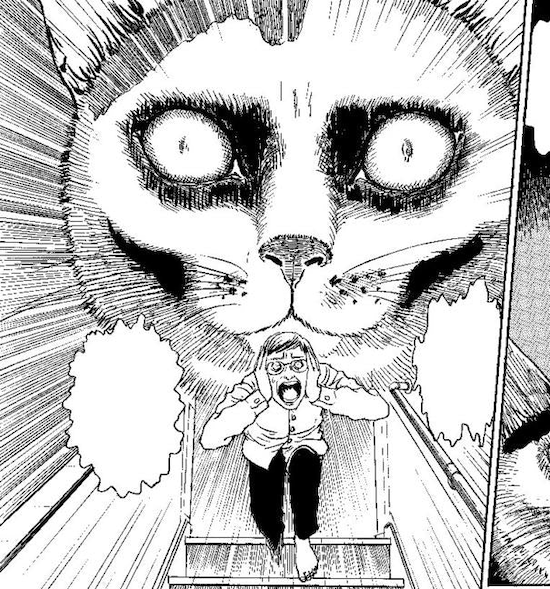Frenzied re-animator of bloated fish guts? Doom-tolling terraformer of rancid hell stars? Cosmic legislator of interminable vortices? The legendary horror comics artist Juni Ito has, at various stages of his career, been all of these things. And yet despite his artistic reputation as an esteemed imagineer of human suffering, whose themes range from the loftiest ethers of the supernatural to the basest matters of bodily trauma, he’s always cut a contrastingly kind and bashful figure.
The author of such singularly confrontational explorations of murder, obsession, and bio-mechanical madness as Tomie (1987), Uzumaki (1998) and Gyo (2001), Ito has never cloaked himself in the pantomimic shadows or transgressive affectations we’ve come to expect from other innovators of the genre (…allow me to lower my wraparound shades while I level a bloodshot eyeball at director Takashi Miike…), instead embodying a shyly equivocal channeler of dark fantasies whose thoughts on fear can be deflatingly terse. “I’m a horror maniac who prefers to stay at home,” he once quipped, evasively. It’s always the quiet ones, right?
Inspired by the ghost stories of Edogawa Ranpo and the non-mythos tales of H.P. Lovecraft, Ito has wrangled ectoplasmic entities, maundering wraiths, and hostile revenants into countless shorts, one-shots, and novels that feel cursed by a maniacal energy. His clean yet obsessive line work uneasily echoes the demented nature of his many protagonists, while re-animating bodily materials such as hair, saliva, sweat, blood, and pus, as the semi-sentient avatars of heightened emotions. “It was a little different to how I imagined ghosts…,” blathers the hapless protagonist of ‘Hanging Blimp’, “There was a sense of reality to it, like I could touch it if I reached out my hand.” And indeed for Ito, the supernatural is far from ephemeral. It’s a shambling, viscous, and corporeally immediate threat.
Born in 1963 in Sakashita (now Nakatsugawa), a semi-rural town in the heartlands of Honshu, Ito was introduced to horror comics as a child by his two older sisters whose hand-me-downs included works by Shinichi Koga and renowned mangaka Kazuo Umezu, author of the trans-dimensional romp The Drifting Classroom (1972-74). In a short comics memoir, ‘Master Umezz And Me’ (2014), Ito would relay the influence of Umezu, recounting that a period spent in hospital with appendicitis was made bearable by the older artist’s Makoto-Chan gag manga (“it made me laugh so hard, even though I had a drain in my stomach”), and how some of his own earliest exercises in comics art were alternative drafts of the Drifting saga.
It’s also an overplayed but nonetheless fantastic anecdote of Ito’s that his childhood trips to the bathroom were taken along a subterranean corridor plagued by spider crickets; a domestic ur-site of insectoid terror that would inspire his anxious curiosity in the narrative uses of Japan’s native arthropods. Golden orb-weaver spiders menace his cursed Souichi stories, while the segmented bodies of millipedes and caterpillars have inspired all manner of demonic contortions, perhaps most memorably in the short story ‘Honored Ancestors’, in which a predatory old man morphs into a centipedal suitor worthy of Naked Lunch’s parasitic Yves Cloquet.
In the early 1980s he’d train as a dental technician, and while his medical education provided a basic anatomical vocabulary for the comics he’d been producing in greater volume, it was the technical lexicon of dental craft that allowed him to create signature tools for composing his works. “I learned techniques I could use to customize those tools, such as cutting and whittling down pens to make them shorter, cutting grooves into the base so they would be easier to hold, sanding them down to make them smooth and clean,” he’s since explained, “that all came from the techniques I learned to shape and finish dentures.” A wonderful episode of the documentary series Manben would later focus on Ito’s pen technique, providing an almost perversely attentive portrait of his idiosyncratic draftsmanship.
It was while working as a technician that Ito’s breakout hit, Tomie, the story of a girl trapped in an appallingly violent cycle of murder and reincarnation, debuted in the pages of Monthly Halloween. A magazine of horror shorts and western film tie-ins (Return Of The Living Dead and Re-Animator among them), Halloween ran from 1986 to 1995, mockingly proffering itself to those in the shōjo (teen girl) demographic who were ‘tired of happiness’, a moody riposte to the kawaii (cute) and rorikon (Lolita complex) aesthetics that had come to dominate the comics markets for both men and women.
Luckily for Ito, the late 80s saw a widespread reconsideration of obscenity in Japanese culture, creating a frothing petri-dish for his experiments in extreme horror. Manga historian Fred L. Schodt has noted that the disappearance of such boundaries led to a “me-too” syndrome in which many magazines vied with each other to “produce the most provocative stories possible”, and while Ito’s works are far from pornographic, they’re a blood-spattered footprint beyond the warmer stylings of their horror comics precursors. The folkloric tale-gathering of Shigeru Mizuki’s GeGeGe no Kitarō (1960-69) or the “Psychic World” of Go Ngai’s Devilman (1972-73) read like children’s picture books in contrast to Ito’s clinical depictions of bodily disintegration.
This isn’t to say that Ito is without his predecessors. Like many mangaka his works tap a long lineage of graphic flirtation with the macabre, and it’s easy to see trans-generational correspondences between say, the monstrous sloshing Koi Carp or detonating Samurai of Utagawa Kuniyoshi’s ukiyo-e (genre of wood block print and painting, popular between the 17th and 19th centuries) and Ito’s intricately-drafted splash pages produced over a hundred years later. Both of which display bodies – both human and non – smashed, eviscerated, or grotesquely decomposed. What Ito inherits, and indeed hones, from such historic antecedents, is the spectacle of disintegration. Where his pen explicates the messy fragments of such processes, often anatomising the sloppy discharge of bodily degradation, his page-turns revel in the momentary shock of the atrocity exhibit, always scraping the furthest spatterings of bodily violence back into the centre of his panels.
Eschatologically in-keeping with his often apocalyptic themes, the turn of the millennium marked an evolution of Ito’s influence in both America and Europe with the translation into english of the world-bending Uzumaki. Anthropologist Ann Allison once characterised the ascendency of the Japanese pop-cultural export through the late 1990s as an age of “millennial monsters”, in which a “cool Japan” was seeded by cute avatars “enchanting commodities” with an almost animist energy. And while Pokémon, Power Rangers, and Hello Kitties hopped between comic books, TV shows and video games with an unprecedented ease, a new calibre of Asian horror cinema was simultaneously reframing our relationship with communications technology itself. Ringu (2000), Pulse (2001), and The Eye (2002) all suggested that broadcast media, the early internet, and medical science could provide charged sites of spectral transmission as potent as the graveyards and haunted houses that preceded them. As hunger for Ito’s work increased, it was more often than not the fan-led process of “scanlation” that brought his tales to the anglophone world, where they were fittingly enveloped by the gloomier recesses of the internet as a form of graphic hearsay alongside “creepy pastas”, gross-out videos, and the retelling of urban legends.
Ito himself has never been served particularly well by film adaptation. 2000’s live action Uzumaki was a strangely camp affair, its comic skits closer in tone to Nobuhiko Obayashi’s sublime spook house caper Hausu (1977) than the cyclonic madness of the original. Perhaps it’s his compulsive pen-craft that carries a darkly obsessive charge so evidently missing from the filmed versions of his work? His inks smudged as they are into malevolent miasmas, powdered into textures that appear to bruise the page. Where auteur director Hayao Miyazaki was able to sustain the linear delicacy of his part work Nausicaä Of The Valley Of The Wind (1982) in its transition from comic book to feature film – in large part due to his monomaniacal presence at production studio Ghibli – Ito has always seemed somewhat detached from the filming of his work. While they both possess nicely phrased moments of comic horror, both Gyo: Tokyo Fish Attack (2012) and anime series The Junji Ito Collection (2018) are marred by a visual spareness that suggest budgetary constraint rather than wilful aesthetic, never matching the visually concentrated malevolence of the originals.
This could change however in 2022, with a new Adult Swim-produced animated series of Uzumaki directed by Hiroshi Nagahama (check out his quietly haunting anime masterpiece, Mushishi) and scored by land-walking human-pufferfish Colin Stetson. First touted in 2019, but delayed by the epoch-ending snub to human ambition we call COVID-19, Uzumaki will air in a world vastly different from the one in which it was first conceived.
Writing for the Japan Times back in 2016, philosopher Eugene Thacker stressed that it was always Ito’s narrative recourse to cosmic ambivalence – to the indifference of the universe to human suffering – that reflected the strange position of the human in our ongoing experience of the ecologically uncanny anthropocene. For Thacker, Ito provided a momentarily sobering yet instructive glimpse of “something on the order of deep time and the scale of the unhuman”. In our present moment of immunological precarity, I’d suggest that Ito’s challenging themes of biological contamination, bodily transformation, and the techniques of assimilation and acceptance that they provoke, also harbour pertinent, albeit difficult lessons. So here’s a good-willed guide of sorts to his wonderful, terrible works. Welcome to the strange world of Junji Ito. Welcome to your world…
Tomie (1987-2000)
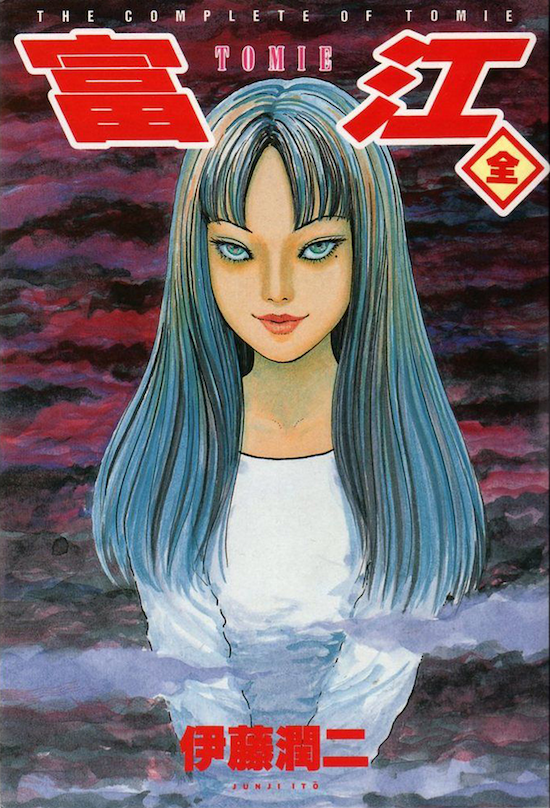
Charged allegory of misogyny’s endless self-reproduction, or private sex-death fantasy? I’ve never been quite sure. Either way, Tomie is the “big one”, the blood-spattered key stone, a complex, 752-page monolith that established Ito as a cracked libidinal psychonaut navigating the desirous circuitries of jealousy and passion. Gathering his scratchiest early strips together with more deftly penned entries between 1987 and 2000, it recounts the misadventures of Tomie Kawakami, a beautiful schoolgirl whose appearance and actions provoke nothing but murderous rage in those around her. Caught in an eternally recurring loop of murder and regeneration, Kawakami comes to function less as a person, more so a revenant dehumanized prism refracting the envy and frustration of those around her. It’s a difficult read at times, best encountered in short bursts, with one eye trained forcibly outwards on the actions of the insecure men populating headlines beyond the book’s pages.
Hanging Blimp (1994)

Inspired by a childhood dream but unrealised until 1994, ‘Hanging Blimp’ blurs phantasmagoric imagery with sobering social observation into one of Ito’s most effective stories. The tale of a city haunted by thousands of floating disembodied heads, each hunting their living likeness with a lank noose, this short demonstrates a signature motif of Ito’s storytelling, where personal paranoias evolve into world-altering events as the city darkens under the shadow of clouds of hanging corpses. While other creators, such as Naoki Urasawa, have authored works that neurotically orbit such significant traumas as the Aum Shinrikyo sarin gas attack on the Tokyo subway in 1995, exploring for example the cultic milieu of charismatic visionaries and urban catastrophes that seemed to occur with all of the unanticipated awfulness of a Kaiju stomp in Japnese society, Ito’s works are usually much less pliable in the service of social commentary. The publication of ‘Hanging Blimp’ however, within a year of Wataru Tsurumi’s best-selling The Complete Manual Of Suicide – a guide book, rating various techniques and their efficacy with “skulls out of five” – lends this tale an uneasy proximity to a troubled reality.
Uzumaki (1998-1999)
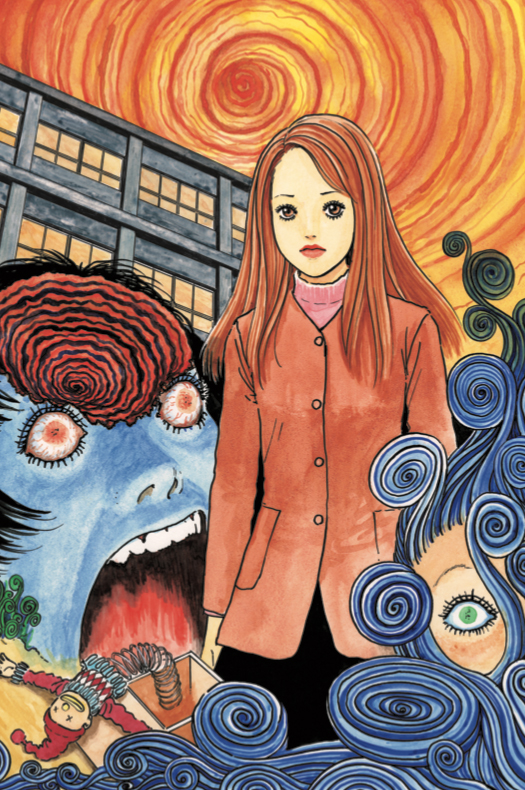
Undoubtedly Ito’s masterpiece, and the work that precedes and often obfuscates his others like a noxious pall, Uzumaki is the story of a town stricken by a bizarre curse. Serialised in Big Comic Spirits from 1998 to 1999, it portrays the residents of the small coastal settlement of Kurouzu-cho who have become obsessed to the point of malign distraction by the simple geometric figure of the spiral. From the curvature of a snail’s shell to the tangles of a teen’s hair, the intimate turn of a potter’s wheel to the wavering gyre of an immense cyclone, Ito builds his obsessive drama through the crazed responses of humans to these apparently benign forms. A tormented father contorts himself into a coiled corpse within the narrow confines of a sake barrel. Young lovers twist themselves into a hideous twin-headed serpentine entity before casting themselves into the ocean. Minds and bodies strain under the incomprehensible perfection of a simple motif. Unlike the fragmentary Tomie, Uzumaki is a cohesive novel with a mind-shattering conclusion, but it’s worth approaching with an attention to the less-spectacular horrors that seep into the bodies of the plot’s lesser characters; the quiet, slime-coated unfortunates whose empathy with the humble snail brings about genuinely creepy transformations. Human escargot.
Gyo (2001-2002)
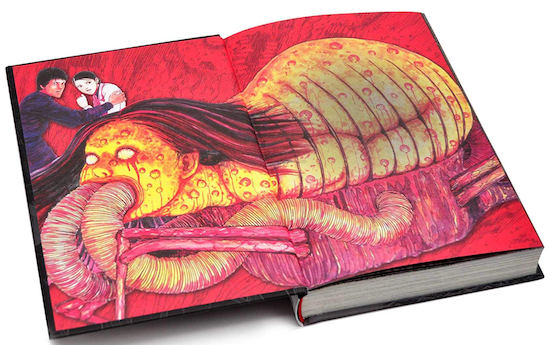
A foetidly sublime exercise in abjection and a comic demonstration of Mary Douglas’s observation that what we perceive as dirt is simply “matter out of place”, Gyo summons the denizens of the sea – yes, all of them – onto land for one big stinky adventure. Mobilised by self-replicating gas-powered spider-leg chassis, the novel imagines a world overrun by fish, sharks, and whales, whose new hunting grounds are the broken remnants of human cities. While the story mutates a very general fear of the oceanic unknown into perhaps the greatest book-length fart joke, it’s notable for its stark military-industrial subtexts, in which clandestine R&D programs change the world and its occupants irreparably. It’s always been a popular game to quiz Ito about what scares him, his responses usually concerning cats, insects or ghosts. But an interview for Japanese magazine Grape in 2019 suggests a deeper anxiety: “When I was a child, my parents, who were of the war generation, would tell me tragic and frightening war stories, so I naturally developed a strong awareness of war as a scary thing. What’s more, as a boy, I was afraid I would be drafted as a soldier when I grew up. This fear of mine naturally developed into anti-war feelings.” As such, Gyo is a peculiar kind of anti-war parable – probably the most acute comment of its kind we’ve seen from Ito – and well worth your time. Oh, and you’ll probably never look at the humble bin bag in the same way again.
Black Paradox (2009)
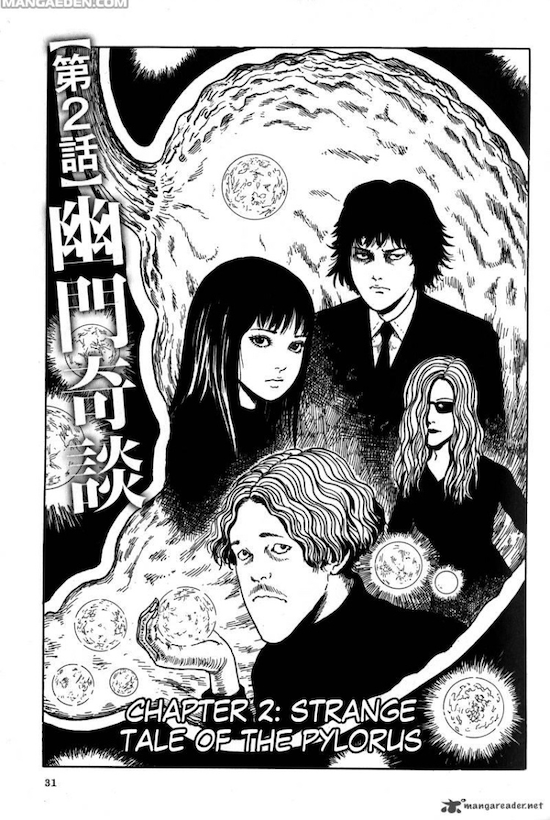
An untranslated personal favourite, but widely available online, Black Paradox is the perfect culmination of Ito’s themes into one devilishly effective story. It also betrays his somewhat roving and opportunistic writerly style, where events leap uncannily from one inexplicable occurrence to the next. Beginning as a the tale of an overly pragmatic but ill-fated suicide pact, the novella soon unfolds into mad riffs on doppelgängers and the human body as an untapped location of resource extraction. It’s best not to spoil this one with anything too telling, but brace yourself for transportive body horror, the mining of bizarre minerals, and a fantastic voyage into abdominal netherworlds.
Junji Ito’s Cat Diary: Yon & Mu (2009)
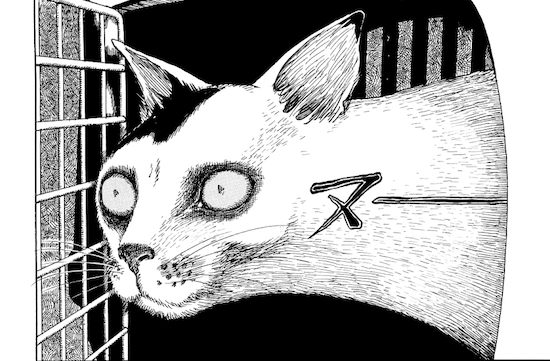
As the title suggests, it’s Junji Ito’s cat diary. The closest we’ll ever get to an Ito biography. Perfect for those who love or hate cats.
Rasputin The Patriot (2010-2012)
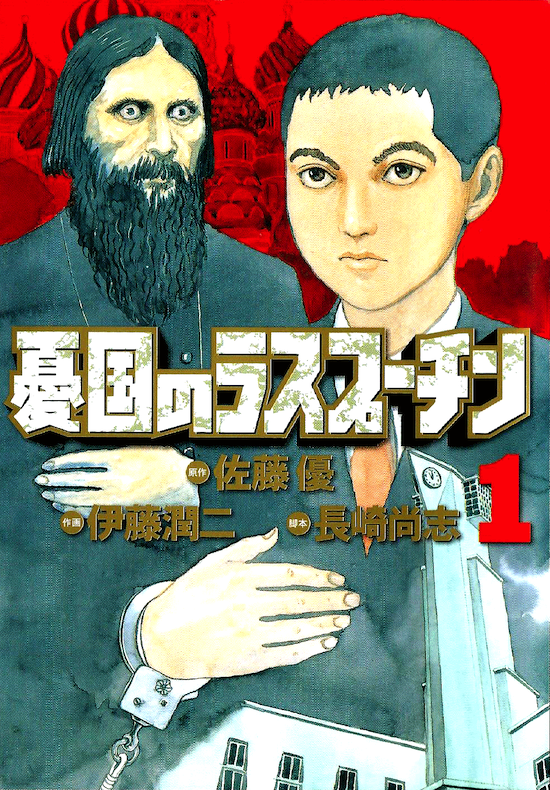
A solid sidestep – both for this list, and for Ito – Rasputin The Patriot (2010-12) is an as-yet untranslated political procedural written by ex-diplomat Sato Masaru, author Takashi Nagasaki, and illustrated by Junji Ito. Adapted from the biography The Trap Of The State (1997), it details Masaru’s real-life experiences working for the Japanese Foreign Ministry in Russia, and how his intelligence work and association with the notorious politician Suzuki Muneo led to him being the target of a deeply sinister political purge. You’ll need to track it down via a scanlation site, but it’s worth encountering for Ito’s distinctive visual framing of constrictive bureaucracies, hollow-eyed prison guards, mannequin-like attorneys, and carceral architectures. A calmly hellish read.
No Longer Human (2017-2018)
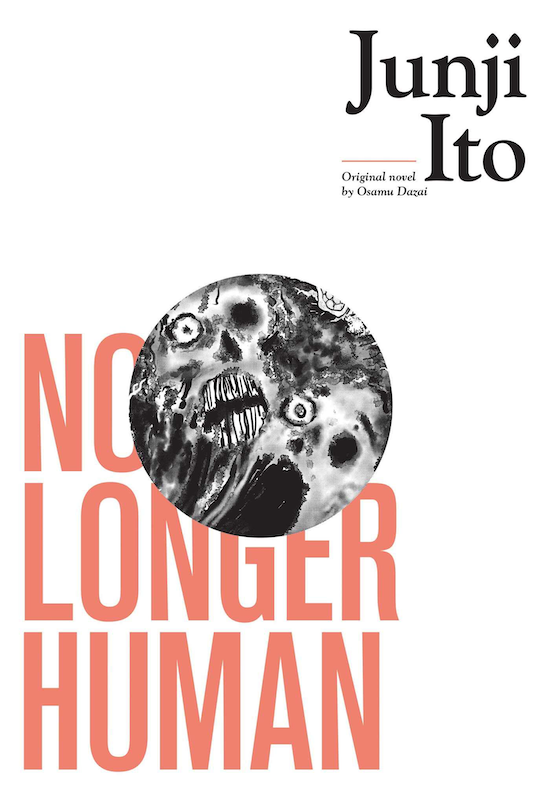
Adapted from Osamu Dazai’s 1948 novel No Longer Human, this despairing, incrementally devastating novel tells the story of Yozo Oba, a young man whose acute perceptions of social artifice drag him into a quagmire of affectless dispassion and psychotically alienated action. Incapable of forming any real connection with those around him, he ambles abusively from lover to lover, pursuing a hazily defined dream of becoming an artist. Ito’s talent for monstrous depiction and grim surrealism bristles against Dazai’s otherwise realist setting here, the communist cells of early 20th century Tokyo depicted as frenetic hornet hives, the bodies of adulterous partners awkwardly entwined as animal grotesqueries. But the real draw here is in Ito’s bracing realisation of Oba’s paintings – something that Dazai could only describe in the original – which punctuate the book as morbid markers of a disaffected psyche; gaseous wraiths peep through a pungent tangle of withered herbs, a portrait collapses under the weight of its own depiction of hopelessness. As Oba’s health declines after multiple failed suicide attempts, we see him stumble upon a snow-blanketed street, eventually vomiting a puddle of blood across a crisp white sidewalk. As the blood resolves itself into the form of a vibrant rising sun, a phalanx of skeletal conscripts marches past on their own forlorn journey to war. Ito’s retelling constantly suspends personal crises under the overbearing weight of a history defined by social obligation. You’ll need plenty of cups of green tea and a comforting mochi or two to get through this one.
Sensor (2019)
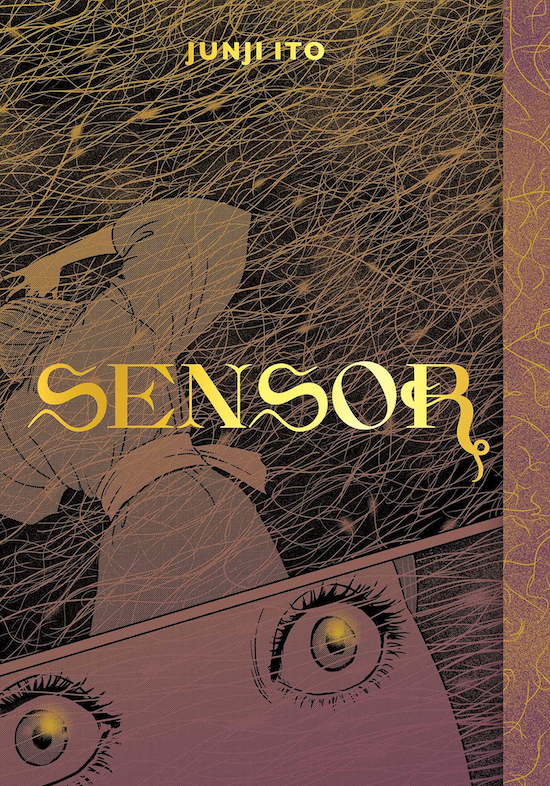
Originally published in 2019 in Japanese as Travelogue Of The Succubus but translated and republished in a stunningly designed volume by Viz as Sensor in 2021, this novel of volcanic cults, and looming demiurges sees Ito extend both his thematic and visual repertoire to the astronomic haze of celestial influence. It’s a short, sharp book, but it’s full of mystery and lingering darkness that’ll leave you poring over his cosmological page spreads. And it’s also, for this reader at least, bizarrely reminiscent of Shūsaku Endō’s 1966 novel Silence, what with its jealous shogunate, Portuguese missionaries and apostatising peasants. Endō, a literary realist with one foot firmly submerged in the catholic baptismal font, has never been a stated influence on Ito, but these books read like strange companion pieces, tapping Japan’s historic hostility towards christianity for profound expressions of pain, suffering and horror.
P.T. (2014)
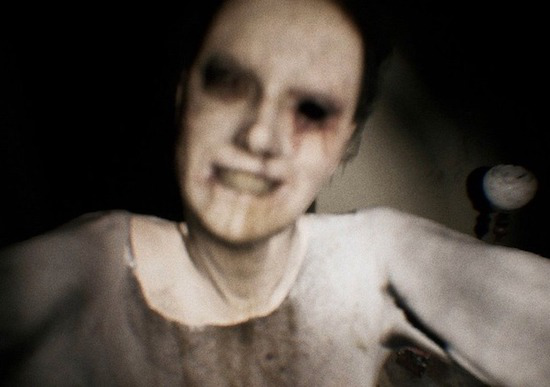
An absolute wild card entry from me here, absolutely non-canon, and borderline heretical. P.T. was the playable demo of Silent Hills, a now cancelled video game that was due to be directed by Hideo Kojima, creator of the Metal Gear (1987-2015) franchise. Ito was pitched to work creatively on the title alongside director Guillermo Del Toro, but difficulties between the game’s publisher, Konami, and Kojima led to its cancellation in 2015. Available to download for a limited time, the demo now exists exclusively on old Playstation units as a grave reliquary, effectively turning these consoles into black boxes haunted by the unrealised future of horror game development. You should certainly watch a play-through on YouTube. It’s terrifying. The game’s spectral antagonist, “Lisa”, glitches her way towards the player in lurches that conflate Kojima’s unique understanding of uncomfortable proximities with Ito’s panel-to-panel mastery. Ito would cameo in Kojima’s post-apocalyptic walking simulator, Death Stranding, in 2019, and it’s easy to see how aspects of his short works – say the clawing, invisible hands that interrogate the living in ‘How Love Came To Dr. Kirida’ – have come to influence gameplay mechanics beyond his books. But despite its cancellation, P.T. stands here as an indication of where Ito’s world of nightmares may be heading. If recent games such as Polish developer Paweł Koźmiński’s Ito-inspired one-bit RPG, World Of Horror (2019), are anything to go by, Ito-esque horror has a compellingly grim future in interactive entertainment. Let’s be sure to keep a haunted channel open in anticipation.
(Renzo Adler’s fantastic history of Monthly Halloween for Zimmerit was indispensable in the writing of this article. As were Fred L. Schodt’s always trusted observations in Dreamland Japan: Writings on Modern Manga (1996). Naoki Urasawa’s TV show, Manben, is an impossibly rich resource on manga creation, and has now been made available unofficially online thanks to the work of tireless fan translators.)

